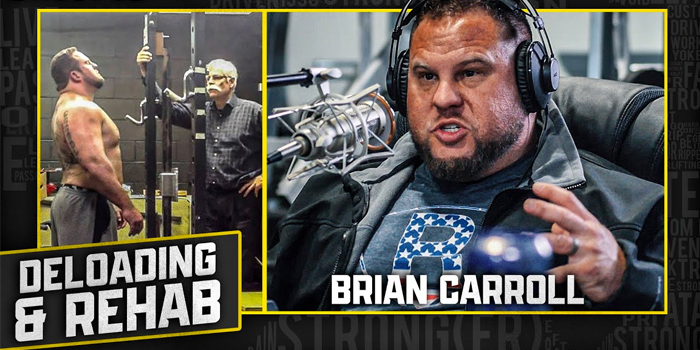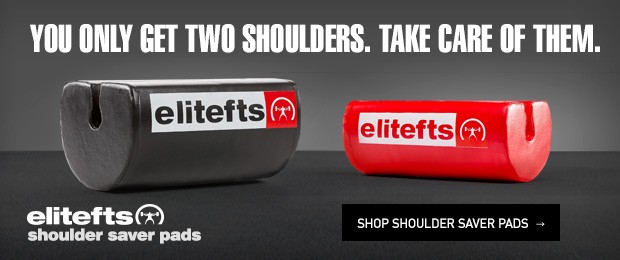
Brian Carroll, Dave Tate, and most other elite-level powerlifters have dealt with back pain or injuries at some point in their life. For Brian, these problems were only resolved when he brought in top expert Dr. Stuart McGill. Dr. McGill helped Brian recover from a devastating back injury and return the top of the sport of powerlifting. They have now collaborated to create a book on the process and how any athlete can bounce back to peak performance.
Stuart McGill’s books and ideas have skyrocketed in strength sports and have helped many people recover from injury and become stronger lifters while living pain-free. Unfortunately, this has meant a dilution of the ideas as they spread in popularity much to the frustration of Brian. Now that he has been garnering momentum in his lifting progress, Dave wanted to know what Brian has kept in his routine now that he has moved out of rehab mode into progress mode. For Dave, after learning all of Stu’s content and applying it to his own rehab, he is now hyper-conscious of his body positioning. He’s careful about his sleep posture, how he sits down, and how he stands up from a seated position. He is sure to keep his core highly tense and not overly flex his spine. So what is it that Brian sees people fucking up?
Fallacies of the Overconfident
Firstly, if you haven’t read Stuart McGill’s books or learned from his program you are only dealing with a glimpse of his full ideas. Stu has written thousands of pages of books, research, and articles and given hundreds of lectures. Basing your knowledge off of a couple of bullet points you’ve seen here or there, you don’t have the full picture.
Secondly, you’re coupling an incomplete knowledge base with false confidence. People often claim to have 10/10 perfect movement quality every second of their day. Brian will ask them to sign a waiver for training and treatment. However, this waiver will be placed on a countertop slightly above waist height. Almost every single time someone stoops over and slumps their shoulders, falling into the poor posture and flexed position. Brian says you have to be loading your hips during everything you do! Bend your knees and sit back to use tables and don’t flex your spine forward. If you have to tie your shoes and you’ve got a big power-gut from your latest dreamer bulk, raise that foot onto something that allows you to lunge and reach your shoes. If you watch a golf player pick up a ball they execute a perfect lunge with zero flexion of the lower back. Replicate this if you ever pick things up off the floor.
Deloads That Work
This all may sound excessive, but it’s the details that matter for fixing pain or chasing elite performance. While you may be an 1100 pound squatter like Brian, picking up a bag or even just a scoop of dog food can cause problems one movement at a time. Your entire body weight is behind every movement you do, and a hundred moves every day can “pick the scab” per Dr. McGill’s terminology. So Brian demands movement perfection. Get your core stiffer than you thought previously possible and perform your exercises every single day with perfect execution. It is an entire system. You need a precise diagnosis of your problem, removal of the cause, and build stronger and pain-free movement capacity. Your bones and connective tissue take months to change, so this is a lifetime commitment. This leads to Brian’s frustrations being shoehorned as the “deload guy.” Brian is big on deloading effectively. Brian isn’t satisfied with people just “bodybuilding” every once in a while as their form of a deload.
“Bodybuilding is a really good way to stay injured for a long time.”
Brian takes a very methodical approach to his deloads. Deloads extend beyond programming and into rehab so they must be treated clinically. His deloads are highly specific, so he wants to completely deload his spine, and only work on exercises that improve the health of his vertebrae. Rehab needs to be highly specific to your goal. Start completely from scratch, and introduce only what you need to build an iron core.
Dave Tate has also seen some asinine methods of deloading. It’s common for powerlifters to try to deload exclusively the spine, which has somehow turned into just the removal of squats. While you have physically removed the weight from the top of your spine, plenty of pressure is still enacted on your vertebrae during lifting. Deadlifts still load the spine! But even bench press, dumbbell overhead press, foo-foo cable bodybuilding work, or rowing motions will all prevent a total deload of the spine. The worst offender is doing heavy lunges while your low back flexes and twists all over the place! Your spine doesn’t measure pressure in pounds on a bar or in a dumbbell, it only knows the result of your cumulative movements.
Text By Mason Nowak














